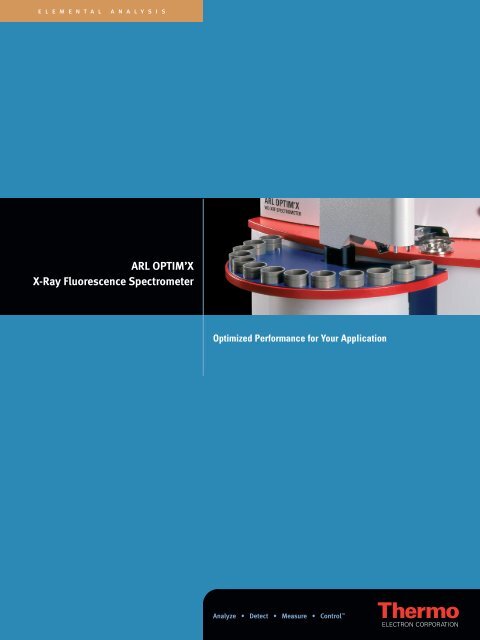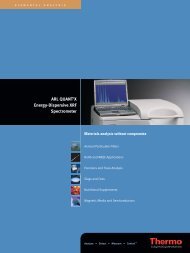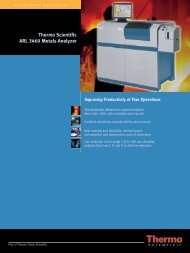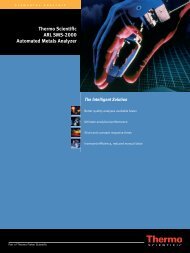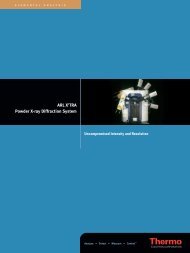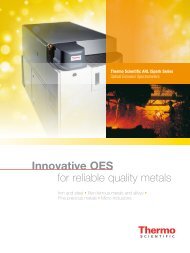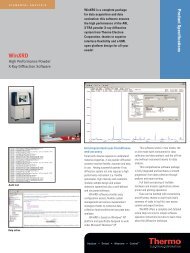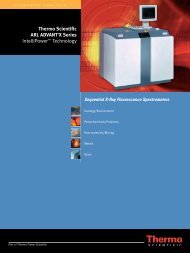ARL OPTIM'X X-Ray Fluorescence Spectrometer - spekom
ARL OPTIM'X X-Ray Fluorescence Spectrometer - spekom
ARL OPTIM'X X-Ray Fluorescence Spectrometer - spekom
- No tags were found...
You also want an ePaper? Increase the reach of your titles
YUMPU automatically turns print PDFs into web optimized ePapers that Google loves.
e l e m e n t a l<br />
a n a l y s i s<br />
<strong>ARL</strong> OPTIM’X<br />
X-<strong>Ray</strong> <strong>Fluorescence</strong> <strong>Spectrometer</strong><br />
Optimized Performance for Your Application<br />
Analyze • Detect<br />
• Measure • Control
<strong>ARL</strong> OPTIM’X<br />
Optimized Performance for Your Application<br />
<strong>ARL</strong> OPTIM’X<br />
Optimized Performance for your Application.<br />
The wavelength dispersive X-ray fluorescence<br />
(WDXRF) technique is one of the most<br />
versatile analytical methods for the chemical<br />
analysis of solids and liquids. Elements from<br />
beryllium to uranium can be analyzed in a<br />
wide variety of samples with accuracy,<br />
precision and reliability. The technique and<br />
the analytical methods are mature enough to<br />
establish clear qualitative and quantitative<br />
characterization of diversified materials.<br />
Modern technological developments have<br />
helped to include WDXRF into reference<br />
methods for analytical laboratories (ASTM<br />
and ISO norms for example) by virtue of their<br />
simplicity, flexibility, affordability and<br />
reliability. The cost per analysis is clearly<br />
advantageous over many traditional wet<br />
chemical and other spectroscopic methods.<br />
• Optimum configuration for specific<br />
applications with simplified operation<br />
(ISO or ASTM standards compliance)<br />
• Stand alone and autonomous operation<br />
without water cooling<br />
• No gas supply required (depending on the<br />
configuration)<br />
• Direct and simple introduction of the<br />
sample<br />
• Automatic analysis of batches with<br />
sample changer<br />
• Small footprint.<br />
Configuration for speed and<br />
flexibility<br />
• Up to 8 elements simultaneously using 4<br />
Multichromators<br />
• Sequential analysis with the<br />
SmartGonio<br />
• Sequential-simultaneous analysis:<br />
SmartGonio and 2 elements<br />
simultaneously on one Multichromator<br />
A compact and independant<br />
WDXRF instrument<br />
Continuing its tradition of innovation and<br />
leadership in WDXRF, Thermo Electron<br />
Corporation presents a new compact<br />
instrument, the <strong>ARL</strong> <strong>OPTIM'X</strong>, with the<br />
following salient analytical features:<br />
• Unique WDXRF platform with sequential<br />
and/or simultaneous capabilities<br />
• Element coverage from fluorine to<br />
uranium, depending on configuration<br />
• Closely coupled optics for increased<br />
intensity (210% higher than conventional<br />
geometry)<br />
• Multichromators for fast analysis;<br />
• Unique compact SmartGonio for<br />
sequential analysis<br />
• Sequential-simultaneous configuration<br />
blending speed to analytical flexibility<br />
• High precision (short term and long term<br />
repeatability) thanks to temperature<br />
regulation of spectrometer and crystals<br />
• Superior spectral resolution from low Z<br />
elements to heavy elements (~15 eV at<br />
CaKα)<br />
Configuration selected according to application needs<br />
Excellent resolution: Si and Al peaks are free from any interference<br />
despite the presence of 55% of Mg in this magnesite sample<br />
Cassettes for manual loading of solids Cells for liquids and loose powder analysis <strong>ARL</strong> OPTIM’X with its sample changer
Exclusive SmartGonio<br />
• Quantitative analysis of any element from F to<br />
Fe or Al to Zn (with one detector fitted)<br />
• Quantitative analysis of any element from Al to U<br />
(with two detectors fitted)<br />
• Angular positioning to ensure θ / 2θ<br />
relationship between crystal and detector is<br />
achieved through Moiré fringe optical encoders:<br />
- no friction<br />
- no wear with time!<br />
• Temperature regulation of crystals for best<br />
analytical stability<br />
• Closest coupling with X-ray tube provides<br />
optimized sensitivity<br />
X-ray tube<br />
Collimator<br />
Optical encoder<br />
Sample<br />
2 theta drive<br />
Detector<br />
Crystal<br />
Optical encoder<br />
1 theta drive<br />
SmartGonio<br />
principle of<br />
operation
<strong>ARL</strong> OPTIM’X<br />
Optimized Performance for Your Application<br />
Optimized for specific<br />
applications<br />
• Petrochemical industry – analysis of S<br />
(ISO 14596 or ASTM D2622), Pb (ASTM<br />
D5059) or other elements in gasoline and<br />
oils<br />
The calibration curve for sulfur in oils and<br />
gasoline can be easily obtained for<br />
concentrations ranging from ppm levels<br />
up to 5% (see Fig. 1). The excellent limit<br />
of detection of 1.4 ppm in 100s (or 1 ppm<br />
in 200s) is achieved. This good result is<br />
proved by the reproducibility test shown<br />
in Table 1. Separate Application Notes<br />
XRF-701 and XRF-706 give additional<br />
details<br />
• Major and minor oxides in raw materials<br />
such as limestone, sand, feldspar,<br />
bauxite, magnesite and other mining<br />
applications as well as clinker and raw<br />
meal. The <strong>ARL</strong> <strong>OPTIM'X</strong> shows excellent<br />
repeatability of analysis for such types of<br />
materials (see Table 2).<br />
As the calibration curve (Fig. 2) proves,<br />
the analysis of Na can be carried out<br />
without problem either with the<br />
SmartGonio or with a fixed channel.<br />
Additional data can be found in separate<br />
Application Notes XRF-702 and XRF-705<br />
• Major and minor oxides in products such<br />
as sanitary ceramics, refractories, slags<br />
and sinters (more details in separate<br />
Application Notes XRF-703 and XRF-704)<br />
• Glass, paints, paper, ferro-alloys, silicon,<br />
metal sheets and other products where a<br />
few major and minor elements need to be<br />
monitored<br />
• Food industry for major and minor<br />
nutrients and other regulated elements.<br />
Typical concentration ranges and the<br />
excellent limits of detection in milk<br />
powders are listed in Table 3 below<br />
Intensity (Kcps)<br />
Intensity (kcps)<br />
0.12<br />
0.10<br />
0.08<br />
0.06<br />
0.04<br />
0.02<br />
0.00<br />
0.025<br />
0.02<br />
0.015<br />
0.01<br />
0.000 0.004<br />
0.008 0.012 0.016 0.020<br />
Concentration<br />
(%)<br />
Fig. 1: Calibration curve for S in oils and gasoline<br />
(zoom on the low concentration level range)<br />
Sample 25ppm 100ppm<br />
Cell 1 25.4 100.6<br />
Cell 2 25.7 100.7<br />
Cell 3 26.4 101.8<br />
Cell 4 26 102.3<br />
Cell 5 25 98.4<br />
Cell 6 25.9 100.5<br />
Cell 7 26.7 101.5<br />
Average 25.9 100.8<br />
Std. Dev. 0.58 1.27<br />
Table 1: Excellent<br />
reproducibility obtained for<br />
analysis of sulfur in oils (120s)<br />
Run nr Al 2 O 3 Ca0 Fe 2 O 3 K 2 O MgO P 2 O 5 SO 3 SiO 2<br />
1 0.329 50.41 0.303 0.116 2.76 0.014 0.036 2.68<br />
2 0.328 50.44 0.303 0.117 2.77 0.015 0.036 2.68<br />
3 0.328 50.45 0.304 0.116 2.74 0.014 0.036 2.68<br />
4 0.324 50.41 0.305 0.117 2.76 0.014 0.036 2.69<br />
5 0.326 50.36 0.301 0.117 2.75 0.014 0.036 2.68<br />
6 0.327 50.38 0.301 0.116 2.74 0.014 0.035 2.69<br />
7 0.327 50.41 0.302 0.116 2.74 0.014 0.036 2.68<br />
AVG 0.327 50.41 0.303 0.116 2.75 0.014 0.036 2.68<br />
Sd.Dev. 0.0015 0.029 0.0014 0.0005 0.011 0.0003 0.0003 0.005<br />
Table 2: Repeatability test for a limestone sample (pressed powder, 100 s counting time)<br />
0.005<br />
0 0.05 0.1 0.15 0.2 0.25 0.3 0.35<br />
Concentration (%)<br />
Fig. 2: Calibration curve for Na using fusion beads of oxides. Standard error of estimate is<br />
0.011% in a range from 0.02% to 0.32%<br />
Table 3: Limits of detection (LoD) in milk<br />
powders prepared as pressed pellets<br />
(*cumulated counting time of SmartGonio<br />
for Na and Mg)<br />
Element Analytical device Typical ranges LoD (ppm in 60s)<br />
Na Fixed channel 0 – 0.03 % 20 ppm*<br />
Mg Fixed channel 0 – 0.12 % 11 ppm*<br />
P SmartGonio 0 – 1.1 % 4.4 ppm<br />
K SmartGonio 0 – 1 % 2 ppm<br />
Ca SmartGonio 0 – 1.6 % 10 ppm<br />
Fe SmartGonio 0 – 0.33 % 2.1 ppm<br />
Cu SmartGonio 0 – 0.012 % 0.6 ppm<br />
Zn SmartGonio 0 – 0.2 % 2 ppm<br />
Cl SmartGonio 0 – 0.48 % 10 ppm<br />
Mn SmartGonio 0 – 0.0023 % 1.2 ppm<br />
Se SmartGonio 0 – 3.4 ppm 0.24 ppm
LARGE VARIETY OF SAMPLES<br />
Many different types of<br />
samples can be analyzed on<br />
the <strong>ARL</strong> <strong>OPTIM'X</strong>: conductive<br />
or non-conductive solids,<br />
liquids, loose powders,<br />
pressed pellets, fusion beads,<br />
pastes. However the<br />
instrument configuration is<br />
optimized for your specific<br />
application.<br />
Manual introduction<br />
of a solid sample<br />
placed in a cassette
<strong>ARL</strong> OPTIM’X<br />
Optimized Performance for Your Application<br />
Data Handling: WinXRF<br />
Designed for Windows® XP Professional,<br />
the comprehensive and user-friendly<br />
WinXRF analytical software supports<br />
spectrometer operation and data handling.<br />
Some of its salient features are:<br />
• Graphical user interface featuring<br />
navigation, operation and display through<br />
HTML pages using Internet Explorer®<br />
• Analytical Assistant helping the operator<br />
in defining analytical programs,<br />
calibrations and basic operations of the<br />
instrument<br />
• Simple routine analysis mode through hot<br />
key operation or software shortcuts<br />
leading to analysis method templates<br />
• Unattended use through batch commands<br />
and sequences<br />
• Correction for curved background<br />
• Variable counting time on peak and<br />
background positions<br />
• Automatic choice of analytical program<br />
according to the intensity or<br />
concentration response<br />
• Type standardization to reach ultimate<br />
analytical accuracy<br />
• User-defined result presentation with<br />
abnormal values marked with flag and<br />
color<br />
• Quality check & quality sort<br />
• Editing and validation of results with<br />
audit trail protected by password<br />
• Recalculation of concentration results for<br />
verification or update purpose, saves<br />
analysis time<br />
• Fast and accurate calibration curve<br />
determination through multi-variable<br />
regression (MVR) facility<br />
• Post-processing functions performed<br />
while the instrument is analyzing, e.g.<br />
results storage and retrieval or statistics<br />
and export (e.g. to Excel spreadsheet)<br />
• SPC-Basic: instrument control with online<br />
integrated SPC (Statistical Process<br />
Control) package<br />
• Audit trail of drift correction, type<br />
standardization update and calibration<br />
changes<br />
• Monitoring and logging of instrument<br />
alarms and status with graphical display<br />
tools<br />
• Password protection with up to 8<br />
different access levels<br />
• Remote diagnostics through modem<br />
connection.<br />
Main software options<br />
• <strong>ARL</strong>net: Package of results transmission<br />
solutions via LAN Local Area Network to<br />
up to 18 destinations. Includes among<br />
others: TCP/IP computer task – to –<br />
computer task transmission, Netfile<br />
transmission of results to files on local or<br />
network disks and printing on network<br />
printers<br />
• Compac: transmission of results to up to<br />
5 computers via serial lines<br />
• Remote: remote display of results to up to<br />
8 remote printers or terminals via serial<br />
lines<br />
• NBSGSC: program for theoretical alphas<br />
generation<br />
• Charge correction: Calculation of furnace<br />
charge additions<br />
• Metaverage: Average of sample analyses<br />
according to pre-configured schemes<br />
• SPC-Full: integrated Statistical Process<br />
Control software for instrument quality<br />
assurance and production process control.<br />
Fully on-line (bi-directional) with<br />
automatic evaluation and SPC test result<br />
feedback to the operator<br />
• Printing of reports of stored analytical<br />
results according to a variety of Thermo<br />
Electron or user defined formats<br />
• Remote Sample Definition: Reception of<br />
sample identification and analysis<br />
parameters from third party application<br />
software (e.g. <strong>ARL</strong> ARMS or process<br />
computer)<br />
• Sentry: allows a simplified sample<br />
registration including bar code support<br />
and powerful sample batch entry<br />
capabilities<br />
• OEM Mode: connection to an external<br />
process computer for automation<br />
purposes<br />
• Translation of WinXRF texts into any<br />
language supported by Windows® XP<br />
Professional<br />
• OptiQuant: Adaptation of the renowned<br />
UniQuant® package to the <strong>ARL</strong> OPTIM’X<br />
spectrometer. OptiQuant provides<br />
"standardless" analysis for up to 73<br />
elements when specific standards are not<br />
available, or when samples can only be<br />
obtained in small quantities or as<br />
irregular shapes. Additionally OptiQuant<br />
calculates the balance of unanalyzed<br />
elements present in the sample, e.g.<br />
organic and ultralight elements. The<br />
OptiQuant optional package is fully<br />
calibrated and pre-installed in the factory<br />
using two fixed channels for Na and Mg<br />
and the SmartGonio. Hence it is ready<br />
to be used right after installation of the<br />
instrument at the customer's site. Stable<br />
samples for setting-up and maintenance<br />
over time are included.<br />
« Standardless » analysis through OptiQuant<br />
MVR calibration curve: real concentrations vs. intensities
Fast qualitative analysis<br />
When a SmartGonio is fitted, two forms<br />
of digital scanning are available. Step<br />
scanning provides precise definition of<br />
peaks with a resolution of 0.001°. For rapid<br />
qualitative analysis, continuous digital<br />
scanning allows fast acquisition of spectra<br />
at speeds up to 320°/min. Peaks<br />
identification is automatic.<br />
Quantitative analysis made easy<br />
Analytical programs and calibrations are<br />
defined with the help of the on-line<br />
Analytical Assistant. Calibration curves are<br />
built using the multi-variable regression<br />
(MVR) program.<br />
Correction models serve to minimize the<br />
influence of interfering elements in<br />
multicomponent matrices and to achieve<br />
better accuracy of analysis. These models are:<br />
• Line overlap correction<br />
• Additive correction on intensities<br />
• Additive correction on concentrations<br />
• Lucas-Tooth: Multiplicative correction on<br />
intensities<br />
• Lachance-Traill: Multiplicative correction<br />
on concentrations<br />
• Lachance-Traill+/Lachance-Traill AC:<br />
Multiplicative and additive corrections on<br />
concentrations<br />
• Comprehensive Lachance (COLA) with 3<br />
term alphas to be used with the optional<br />
NBSGSC fundamental parameters<br />
program, which can simulate analytical<br />
calibrations for homogeneous materials.<br />
Interelement correction factors<br />
(theoretical alphas) are calculated and<br />
used as known coefficients in the MVR.<br />
This minimizes the number of standards<br />
necessary to produce calibrations and<br />
improves the accuracy of analysis.<br />
The Analytical Assistant helps definition of analytical programs,<br />
calibrations and instrument use<br />
Easy navigation and comfortable operation<br />
In addition, ex-works calibrations can<br />
be delivered for various materials such as<br />
various oxides through the General Oxide<br />
calibration, several metal matrices, ferroalloys<br />
and others for which analytical<br />
specifications are available on request.<br />
Quantitative analysis - Typical results presentation with flagged<br />
values<br />
Statistical Process Control - Typical screen
Specifications for the <strong>ARL</strong> OPTIM’X<br />
Element range<br />
<strong>Spectrometer</strong> environment<br />
<strong>Spectrometer</strong> design<br />
<strong>Spectrometer</strong> arrangement<br />
<strong>Spectrometer</strong> capacity<br />
X-ray excitation<br />
Multichromator<br />
SmartGonio<br />
Counting electronics<br />
Sample loading<br />
Sample holders<br />
Dimensions and weight<br />
Laboratory information<br />
Power requirements:<br />
Fluorine (Z=9) to uranium(Z=92)<br />
Vacuum or air for solids, helium for liquids and loose powders<br />
Analysis devices contained in a vacuum chamber made of grey cast iron and temperature<br />
controlled<br />
X-ray tube inclined at 66° under sample<br />
Simultaneous configuration: Four Multichromators<br />
Sim-seq configuration: One SmartGonio + one Multichromator<br />
Each Multichromator is composed of two fixed channels<br />
Air cooled Rh anode end window tube with thin Be window (0.075 mm). 50 W power<br />
providing excitation similar to 200 W thanks to ultra close coupling and large solid angle<br />
irradiation. Other anodes available on request. Solid-state high frequency generator of<br />
maximum voltage 50 kV and maximum current 2 mA (combinations chosen to be less than<br />
50W). Max. line voltage variation: 230V -15% to +10%. Stability: ± 0.0002% per 1% variation<br />
Fixed channel using multiple curved crystal optics. Sealed detectors available for all<br />
elements from sodium (Z=11). Flow proportional or scintillation detectors also available<br />
depending on element. Dual pulse height integration to discriminate and correct for 2nd<br />
order peaks. A Multichromator is composed of two fixed channels, but some elements can<br />
only be fitted as single channel monochromator<br />
Fully automatic, gearless, microprocessor controlled compact goniometer using optical<br />
encoders. Total angle range: 0°-150° 2θ (Flow proportional counter: 17°-150°, Scintillation<br />
counter: 0°-90°). Continuous digital scans: from 0.25°/min to 320°/min<br />
Multi-channel analyzer to discriminate peaks of higher energies. Digital Automatic Gain<br />
Control (AGC) for pulse shrinking correction. Automatic dead time correction ensures linearity<br />
of response up to 2 Mcps on flow proportional counter and 1.5 Mcps on scintillation counter<br />
Basic: 1 position for cassette or liquid cell. Optional: 13 position autosampler<br />
Sample cassettes with maximum size of sample: height 26 mm, diameter 52 mm. Liquid cell:<br />
height 22 mm, external diameter 40 mm. Exposed opening: 29 mm diameter (basic). Rotation<br />
of sample holder in analysis position: 6 to 60 rpm<br />
H 126 cm, W 88 cm, D 82 cm with basic sample changer. System weight: approximately 250 kg<br />
Optional phone service support through modem connection<br />
1.5 kVA single phase<br />
Safety standards: Electrical and protection: IEC 1010-1, IEC 950<br />
Radiation (fully protected system): ORaP (CH) 414.501 and BGB1.I. norms<br />
Electro-magnetic immunity: CENELEC EN 50081-2 + EN 50082-2 (industrial)<br />
Thermo Electron Corporation reserves the right to vary these specifications without prior notice<br />
In addition to these offices, Thermo<br />
Electron Corporation maintains a<br />
network of representative organizations<br />
throughout the world.<br />
Australia<br />
+61 2 9898 1244 • analyze.au@thermo.com<br />
Austria<br />
+43 1 333 50340 • analyze.at@thermo.com<br />
Belgium<br />
+32 2 482 30 30 • analyze.be@thermo.com<br />
Canada<br />
+1 800 532 4752 • analyze.ca@thermo.com<br />
China<br />
+86 10 5850 3588 • analyze.cn@thermo.com<br />
France<br />
+33 1 60 92 48 00 • analyze.fr@thermo.com<br />
Germany<br />
+49 6103 4080 • analyze.de@thermo.com<br />
Italy<br />
+39 02 950 591 • analyze.it@thermo.com<br />
Japan<br />
+81 45 453 9100 • analyze.jp@thermo.com<br />
Netherlands<br />
+31 76 587 98 88 • analyze.nl@thermo.com<br />
Nordic<br />
+46 8 556 468 00 • analyze.se@thermo.com<br />
South Africa<br />
+27 11 570 1840 • analyze.sa@thermo.com<br />
Spain<br />
+34 91 657 4930 • analyze.es@thermo.com<br />
Switzerland<br />
+41 21 694 71 11 • analyze.ch@thermo.com<br />
UK<br />
+44 1442 233555 • analyze.uk@thermo.com<br />
USA<br />
+1 800 532 4752 • analyze.us@thermo.com<br />
www.thermo.com<br />
Laboratory Solutions Backed by Worldwide Service<br />
and Support<br />
State-of-the-art instruments are only the beginning with Thermo Electron.<br />
Comprehensive service and support programs are offered on our products<br />
worldwide by a network of factory trained and highly qualified scientists<br />
and engineers. Our experts help you choose the right instruments for your<br />
lab, then keep the instruments performing to specification.<br />
Contact us today for more information on how our specialized sales and<br />
service engineers can help you meet your laboratory needs.<br />
Thermo Electron SA, Ecublens,<br />
Switzerland is ISO certified.<br />
©2003 Thermo Electron Corporation. All rights reserved.<br />
UniQuant® is a registered trademark of Omega Data<br />
Systems B.V. MS Windows® is a registered trademark<br />
of Microsoft Corp. All other trademarks are the property<br />
of Thermo Electron Corporation and its subsidiaries.<br />
Specifications, terms and pricing are subject to change.<br />
Not all products are available in all countries. Please<br />
consult your local sales representative for details.<br />
BR41062_E 11/03C<br />
XRF-02-1062-1103-CH-e


